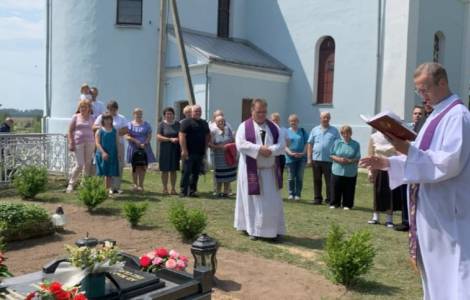
Višnevo (Agenzia Fides) - On Friday, July 13, in Višnevo, a Belarusian town near the border with Lithuania, the new tomb where the remains of Father Stanisław Michalski SJ, a Polish Jesuit who died as a martyr at Christmas 1950, was blessed. For some time, people had wanted to give the priest a more important burial, in order to remember and make known to new generations the figure of a man who directly experienced persecution under the Nazis, then under the Communists, and who chose to remain until the end with the people entrusted to his pastoral care, as we read on the new tombstone: "I have an ardent desire: that of continuing to resist here, even if it is very difficult, I want to resist to the end, like the Good Shepherd who gives his life for his sheep" (excerpt from a letter from Father Michalski to the provincial, dated January 28, 1946).
The rite of blessing of the tomb and the Eucharistic celebration which preceded it saw the participation of the Jesuits Viktor Zhuk, parish priest of St Vladislav in Vitebsk, and Ryszard Matejuk, invited for a few days from Poland; the Salesian priests Artur Leszniewski, responsible for making Father Stanisław Michalski known, and Paweł Szczerbicki, responsible for the Salesian mission in Belarus, as well as two members of the Belarusian diocesan clergy: Father Iosif Mel'djuk, vicar of the Visitation parish of Mary in Višnevo, and Father Vadim Survila, from Vojstam.
The project of the new tomb was supervised by Father Artur Leszniewski SDB, whose vocation was born at the burial place of Father Stanisław Michalski, as he recalled during the Eucharistic service: “It is thanks to Father Stanisław that my priestly vocation was born. I remember that since my childhood, my grandmother took me to his grave and we prayed together for new vocations. Father Stanisław spoke to me and became for me an example of a good priest. My grandmother told me about the time when Father Stanisław, to help my great-grandmother and her children, who was widowed after her husband was killed by communists, had put under the tablecloth, during a visit, all the money collected for the repair of the church. Thanks to this gesture, my family survived” (jezuity.by).
The discreet charity practiced by Father Michalski still largely needs to be brought to light. “When the news of the blessing of the new grave spread,” Father Viktor Zhuk told Fides, "we were informed of another similar case by a priest whose original family had been helped in the same way by Father Michalski, without whose help would probably have died of misery”.
Born on May 1, 1912 in a small town near Poznan, to Józef and Józefa Michalski, Stanisław entered the Society of Jesus when he was only sixteen years old. From 1930 to 1935 he studied at Pinsk college, where he received his secondary school diploma. From September 1935 to May 1938, he studied in Krakow, at the Faculty of Philosophy of the Society, then went to Vilnius to follow theological training. On March 24, 1942, along with other priests, he was arrested by the Nazis and imprisoned until October 30, 1942, when he was deported, without trial, to a concentration camp near Kaunas.
In July 1944, with the approach of Soviet troops, he managed to leave the camp and, on August 5, returned to Vilnius, where he was ordained priest on October 3, 1944. Sent to exercise his pastoral service, first as assistant parish priest, then as parish priest, in Višnevo and Bogdanów, he was repeatedly subjected to punitive expeditions by members of the Komsomol (Union of Communist Leninist Youth), before whose intimidation and torture he did not give in. On the eve of Catholic Christmas 1950, he was severely beaten and died the next day from his injuries. Shortly before his death, he asked those present to pray that there would never be a shortage of new priestly vocations in these difficult times for the clergy and all the faithful. This is what the faithful did and continue to pray at the Jesuit's tomb in Višnevo.
In the current organizational structure of the Society of Jesus, the current Russian region, linked to the Northern Poland Province, includes Russia, Belarus and Kyrgyzstan. In Belarus, there are currently two Jesuits in the city of Vitebsk. Spiritual exercises according to the Ignatian method, lasting one week, are offered regularly in Belarus and Kyrgyzstan. (CD) (Agenzia Fides, 16/7/2024)